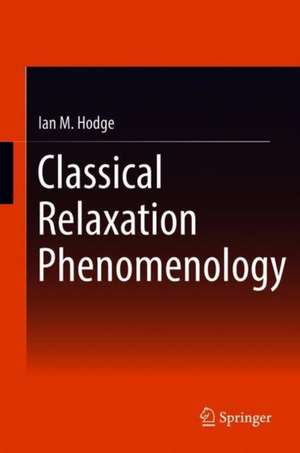Classical Relaxation Phenomenology
Autor Ian M. Hodgeen Limba Engleză Hardback – 19 feb 2019
This book serves as a self-contained reference source for engineers, materials scientists, and physicists with an interest in relaxation phenomena. It is made accessible to students and those new to the field by the inclusion of both elementary and advanced math techniques, as well as chapter opening summaries that cover relevant background information and enhance the book's pedagogical value. These summaries cover a wide gamut from elementary to advanced topics.
The book is divided into three parts. The opening part, on mathematics, presents the core techniques and approaches. Parts II and III then apply the mathematics to electrical relaxation and structural relaxation, respectively. Part II discusses relaxation of polarization at both constant electric field (dielectric relaxation) and constant displacement (conductivity relaxation), topics that are not often discussed together. Part III primarily discusses enthalpy relaxation of amorphous materials within and below the glass transition temperature range. It takes a practical approach inspired by applied mathematics in which detailed rigorous proofs are eschewed in favor of describing practical tools that are useful to scientists and engineers. Derivations are however given when these provide physical insight and/or connections to other material.
- A self-contained reference on relaxation phenomena
- Details both the mathematical basis and applications
- For engineers, materials scientists, and physicists
Preț: 645.79 lei
Preț vechi: 759.76 lei
-15% Nou
Puncte Express: 969
Preț estimativ în valută:
123.60€ • 127.38$ • 104.35£
123.60€ • 127.38$ • 104.35£
Carte tipărită la comandă
Livrare economică 03-17 martie
Preluare comenzi: 021 569.72.76
Specificații
ISBN-13: 9783030024581
ISBN-10: 303002458X
Pagini: 357
Ilustrații: XVII, 256 p. 12 illus.
Dimensiuni: 155 x 235 mm
Greutate: 0.57 kg
Ediția:1st ed. 2019
Editura: Springer International Publishing
Colecția Springer
Locul publicării:Cham, Switzerland
ISBN-10: 303002458X
Pagini: 357
Ilustrații: XVII, 256 p. 12 illus.
Dimensiuni: 155 x 235 mm
Greutate: 0.57 kg
Ediția:1st ed. 2019
Editura: Springer International Publishing
Colecția Springer
Locul publicării:Cham, Switzerland
Cuprins
Part1: Mathematics.- Chapter1. Advanced Function.- Chapter2. Elementary Statistics.- Chapter3. Complex Variables and Functions.- Chapter4. Other Functions.- Chapter5. Relaxation Functions.- Part2: Electrical Relaxation.- Chapter6. Introduction to Electrical Relaxation.- Chapter7. Dielectric Relaxation.- Chapter8. Conductivity Relaxation.- Chapter9. Examples.- Part3: Structural Relaxation.- Chapter10. Thermodynamics.- Chapter11. Structural Relaxation.
Notă biografică
Ian Hodge received his PhD in physical chemistry from Purdue University and studied in the departments of chemistry of the University of Aberdeen in the UK and McGill University in Montreal. He was a member of the research staff at the B F Goodrich Research Laboratories and later joined the Research Laboratory of Eastman Kodak. He then taught introductory physics at the Rochester Institute of Technology before retiring from there. He has almost 50 publications to his name, of which 12 have more than 100 citations, and an h-index of 28.
Textul de pe ultima copertă
This book serves as a self-contained reference source for engineers, materials scientists, and physicists with an interest in relaxation phenomena. It is made accessible to students and those new to the field by the inclusion of both elementary and advanced math techniques, as well as chapter opening summaries that cover relevant background information and enhance the book's pedagogical value. These summaries cover a wide gamut from elementary to advanced topics.
The book is divided into three parts. The opening part, on mathematics, presents the core techniques and approaches. Parts II and III then apply the mathematics to electrical relaxation and structural relaxation, respectively. Part II discusses relaxation of polarization at both constant electric field (dielectric relaxation) and constant displacement (conductivity relaxation), topics that are not often discussed together. Part III primarily discusses enthalpy relaxation of amorphous materials within and below the glass transition temperature range. It takes a practical approach inspired by applied mathematics in which detailed rigorous proofs are eschewed in favor of describing practical tools that are useful to scientists and engineers. Derivations are however given when these provide physical insight and/or connections to other material.
- A self-contained reference on relaxation phenomena
- Details both the mathematical basis and applications
- For engineers, materials scientists, and physicists
Caracteristici
A self-contained reference on relaxation phenomena Details both the mathematical basis and applications For engineers, materials scientists, and physicists
